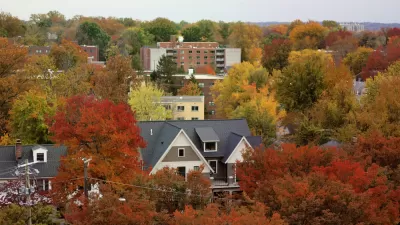In the wake of mass resignations at the county’s planning board, the county council will vote to update their growth plan to reflect the region’s changing economy and demographics.

The Montgomery County Council is poised to approve a new long-range growth plan, dubbed Thrive 2050, for the region that will account for its growing and increasingly diverse population and economy. The vote comes after the county’s planning board resigned en masse due to several scandals.
In an article for the Washington Post, Katherine Shaver writes, “The plan acknowledges massive demographic shifts in a county struggling with how to better compete for businesses and jobs while becoming more walkable, transit-friendly and environmentally sustainable.”
The plan focuses on encouraging transit-oriented development and more diverse and affordable housing types, such as duplexes and small multifamily buildings. “More of such housing in wealthier and highly desirable neighborhoods zoned solely for single-family homes would make the county and its schools less segregated by race and income, planners say.”
Residents are divided over the plan, with some voicing concerns that higher density could imperil the county’s public infrastructure and reduce quality of life. Montgomery council member Hans Riemer dismissed criticism, saying that the plan “doesn’t cause growth to happen. It seeks to manage the growth that’s coming.”
“Planners say Thrive would be the county’s first long-term plan to prioritize racial equity and social justice, including by encouraging less expensive housing in upscale areas.” The plan also directs development toward the eastern part of the county, which, according to planners, “became relatively less attractive for employers and residents, feeding a cycle of stagnation” after the county’s original plan discouraged commercial development and investment along Route 29.
FULL STORY: Suburb’s 30-year growth plan fuels debate over denser development

Trump Administration Could Effectively End Housing Voucher Program
Federal officials are eyeing major cuts to the Section 8 program that helps millions of low-income households pay rent.

Planetizen Federal Action Tracker
A weekly monitor of how Trump’s orders and actions are impacting planners and planning in America.

Ken Jennings Launches Transit Web Series
The Jeopardy champ wants you to ride public transit.

Opinion: Transit Agencies Must View Service Cuts as Last Resort
Reducing service could cripple transit systems by pushing more riders to consider car ownership, making future recovery even less certain.

‘Smart Surfaces’ Policy Guide Offers Advice for Building and Maintaining Urban Tree Canopies
Healthy, robust tree canopies can reduce the impacts of extreme heat and improve air quality.

New Jersey Lawsuit Targets Rent-Setting Algorithms
The state of New Jersey is taking legal action against landlords and companies that engage in what the state’s Attorney General alleges is illegal rent fixing.
Urban Design for Planners 1: Software Tools
This six-course series explores essential urban design concepts using open source software and equips planners with the tools they need to participate fully in the urban design process.
Planning for Universal Design
Learn the tools for implementing Universal Design in planning regulations.
Heyer Gruel & Associates PA
Ada County Highway District
Institute for Housing and Urban Development Studies (IHS)
City of Grandview
Harvard GSD Executive Education
Toledo-Lucas County Plan Commissions
Salt Lake City
NYU Wagner Graduate School of Public Service





























